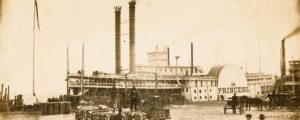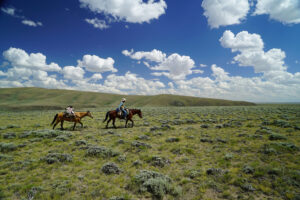Settled in 1858 in the southeastern corner of Mason County, the community was first called Cold Springs after the source waters that fed nearby Cold Creek. German immigrant farmers heavily populated the area. Even today the German influence remains prevalent around Fredericksburg, 25 miles to the south.
In 1869 one of the early pioneers, John O. Meusebach, built a general store and named the place Loyal Valley, reportedly out of his personal loyalty to the Union during the Civil War. He platted the town and served as its postmaster, justice of the peace and notary public. Meusebach remained there until his death in 1897.
As the town grew in the 1870s it opened a church, a school, several small stores and a livery stable. Loyal Valley’s primary agricultural products were cotton and cattle. A two-story inn served as a stagecoach stop for the route between San Antonio and El Paso. Operating the inn was Auguste Buchmeier (or Buchmeyer), whose first husband, Moritz Lehmann, had died in 1862. A year later she had married stonemason Philip Buchmeier.
A notable story out of Loyal Valley concerns the Buchmeiers’ children. One afternoon in May 1870 in a wheat field near the family home, Apache raiders accosted their sons, Herman and Willie, and daughters Caroline and Gusta. The Apaches took Herman, 10, and Willie, 8, captive. After shooting arrows at young Caroline, the Indians assumed they had killed her, but she had fallen when she fainted. Baby Gusta was also unharmed.
A few days later Willie was able to escape when a passing cavalry patrol spooked the Apaches, one of whom tossed the boy from horseback in his haste to fee. Herman remained with his captors. Over the next several years they raised him as an Apache and taught him their ways.
In his fifth year of captivity Herman was forced to kill a medicine man in a fight. Knowing this meant certain death at the hands of vengeful warriors, he left the Apaches. Quanah Parker’s Comanches ultimately accepted Herman into their tribe, and he lived with them for four years.
Herman found his return to white society at age 19 traumatic. It was difficult to give up the Indian lifestyle he had learned. White man’s clothing and food was foreign to him, and becoming “civilized” again was an arduous process for both Herman and his family.
Eventually Herman married and had his own family. At nearby Cherry Springs he opened a saloon and dance hall on the main route between Mason and Fredericksburg. In 1927 he published the memoirs of his captivity in Nine Years Among the Indians: 1870–1879, often regarded as a definitive look at frontier life among the Indians. Herman Lehmann died in February 1932 and is buried in the small cemetery in Loyal Valley.
Around the turn of the century a local baseball team, the Loyal Lads, began competing against other communities. Horse races on the adjoining prairie were also popular. The population numbered fewer than 200 at the time and would decline, especially after the stage stopped running and weary travelers no longer stopped in Loyal Valley. By 1919 the post office had closed. People gravitated to Mason and Fredericksburg to do business. By the mid-1930s the population had plummeted to some two dozen residents, and the San Antonio highway bypassed the town in the 1950s. Today Loyal Valley, just east of I-87, is undergoing preservation efforts.
Originally published in the April 2014 issue of Wild West. To subscribe, click here.




